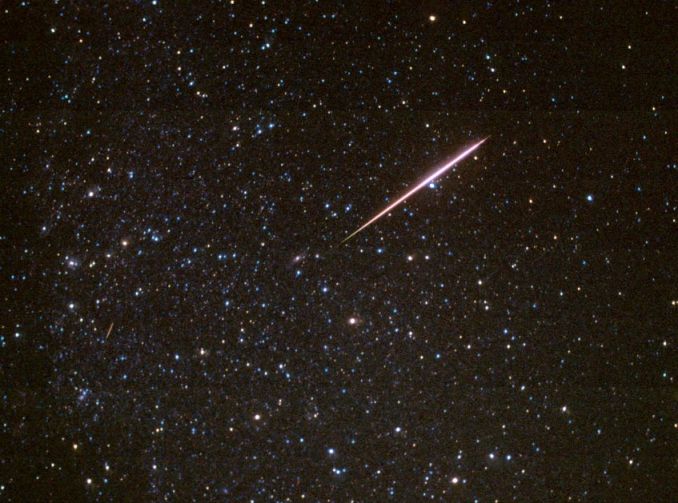Credit: Rick Scott &
Joe Orman
Explanation:
Like falling
stardust,
cast off bits of comet
Swift-Tuttle hurtle through
the upper atmosphere about this time each year as planet Earth passes
near the comet's orbital path.
For the northern hemisphere, this
regular
celestial display is known as the annual
Perseid
meteor shower -- so named because the meteor trails
all appear traceable to a common "radiant point" in the
constellation Perseus.
This gorgeous wide-angle
photo from the 1997 shower
captures a
20-degree-long
fireball meteor
and another, fainter Perseid
meteor trail in a rich area of the northern
summer Milky Way.
A labeled version
is available identifying
the shower's radiant point,
surrounding deep-sky objects, and constellations.
Easy to view (just go outside and look up!), the
Perseid meteor
shower will peak this weekend with maximum rates anticipated
early Sunday morning, August 12, for eastern North America.
Despite interfering moonlight,
last year's faithful
Perseid watchers
were rewarded with bright meteors and extensive displays of
the
northern lights.
1999 2000 2001 2002 2003 2004 2005 2006 2007 2008 2009 2010 2011 2012 2013 2014 2015 2016 2017 2018 2019 2020 2021 2022 2023 2024 2025 |
Январь Февраль Март Апрель Май Июнь Июль Август Сентябрь Октябрь Ноябрь Декабрь |
NASA Web Site Statements, Warnings, and Disclaimers
NASA Official: Jay Norris. Specific rights apply.
A service of: LHEA at NASA / GSFC
& Michigan Tech. U.
|
Публикации с ключевыми словами:
comet - кометы - Метеорный поток - Perseids - meteor shower - Персеиды
Публикации со словами: comet - кометы - Метеорный поток - Perseids - meteor shower - Персеиды | |
См. также:
Все публикации на ту же тему >> | |
